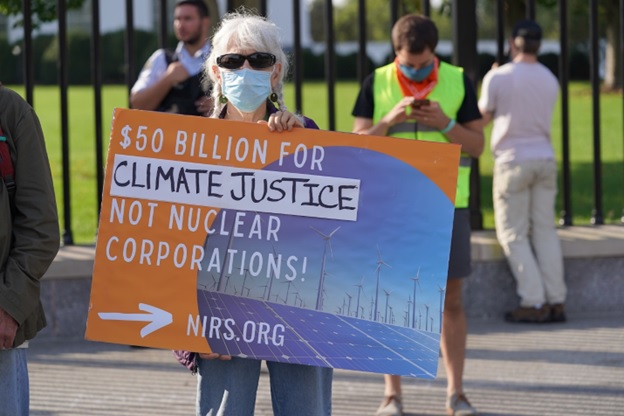
Nuclear Power Makes a Comeback in Central Asia and Beyond
Photo and report by Phil Pasquini
Washington, DC

With the world awash in countless power-hungry cloud-computing and AI data centers, crypto mining farms, growing fleets of electrical vehicles, new all-electric homes and commercial buildings, existing power generation capacity and distribution grids globally are experiencing overloads and power supply shortages.
In the US, operators are looking at increasing the electrical power supply by 3.5 gigawatts of additional generating power which is enough to power three million homes. To meet the ever-increasing demand, plans call for reactivating older nuclear power plants (NPPs) with one in Michigan having recently been restarted.
Central Asia also finds itself in similar circumstances in meeting its present and future electric power supply needs and is now looking to construct new generation nuclear reactors to meet those goals.
The Center for the National Interest, a Washington, DC think tank on US foreign policy, hosted a panel discussion, “Nuclear Power in Central Asia: The New “New Thing”? on January 28 as part of a series organized by the Center’s Central Asia Connectivity Project.
The program centered on three of the five Central Asian countries, Kazakhstan, Uzbekistan, and Kyrgyzstan, regarding the construction of nuclear reactors to meet both the present and future power demands for their growing economies and populations. Of the three, only Kazakhstan previously had a Soviet-era fast-breeder nuclear reactor that was later decommissioned in 1999.
In the fall of 2024, Kazaks voted 73 percent in favor of a controversial referendum to build the country’s first new generation NPP in the next ten years to phase out its aging and polluting carbon-based coal, oil, and natural gas-fired electrical power generating plants in reducing both their carbon footprint and dependence on Russian electrical energy imports.
An article in the Astana Times on January 28 quoted President Tokayev addressing Kazakhstan’s increasing electrical energy shortages by announcing a plan that would increase its generating capacity by at least three gigawatts in the next two years. To achieve self-sufficiency, Tokayev called for “…accelerating the construction of the country’s first NPP and creating a broader nuclear cluster…to develop long-term plans for the nuclear industry’s advancement.” He also called for developing plans to select the most suitable locations for the plant’s construction “while adopting modern, safe technologies.”
No plan to construct a NPP is without its critics and opposition, as panelist Elvira Aidarkhanova of the Center for the National Interest noted. She explained that Kazakhstan’s “historical trauma” of the Soviet era which saw 456 nuclear explosive tests during the Cold War at the Semipalatinsk Test Site, was reason enough for some to resist the proposed nuclear power plants. She further cited safety and environmental concerns along with “fears of corruption” if Russia’s state-owned Rosatom is selected as the contractor and “geopolitical vulnerability” regarding financing that many are fearful would increase dependency on Moscow.
Paul Saunders, president of the Center for the National Interest, likened this dependency “in some respects as an instrument of foreign policy” for ancillary services he referred to as the “printer and toner” conundrum revolving around the life of a NPP that could last as long as 80 years.
Kazakhstan's Ministry of Energy recently noted in a statement that four contractors are being considered for the project, including Rosatom along with Korea’s KHNP, China’s CNNC, and France’s EDF.
Ecological impact of Kazakhstan’s new $10 to $12 billion NPP centers around the planned site on the shore of Lake Balkhash, the second largest salt lake in the world. Specific issues regarding the lake’s environment are its decreasing water level, increased salinity, pollution, global warming-related issues, and “thermal pollution.” The prospective negative environmental impacts on the lake are reminiscent of those that Kazakhstan and Uzbekistan have previously experienced regarding the destruction of the once viable Aral Sea that was destroyed by Soviet-era water diversions for cotton farming in the 1960s.
Another caution raised is Russia’s growing global “nuclear energy diplomacy” in which NPP projects in 54 countries are heavily involved with Russian financing, design, construction, uranium enrichment, maintenance and fuel production, fueling, fuel disposal, and decommissioning, along with the development of wind and hydrogen energy, supercomputers and software.
Other operative concerns of caution are contained in the lingering legacies of the catastrophes at Three Mile Island, Chernobyl, and Fukushima. Along with the yet-to-be-adequately-resolved long-term disposal of spent nuclear fuel and the environmental toll the nuclear industry would like to push aside are the real-world long-term ramifications of the global re-nuclearization of the power industry. To assuage those very real concerns, the nuclear energy industry is now promoting itself as a “green carbon-free power” alternative.
Nuclear-generated power is not new in Kazakhstan. The mining of uranium ore remains a valuable major Soviet legacy industry. Together Kazakhstan and Uzbekistan produce over half the world’s supply with Kazakhstan, the largest producer, accounting for 47 percent of global production while Uzbekistan produces around six percent.
Central Asian expert and scholar Roger Kangas asked why the region is looking towards nuclear power when they are rich with and largely dependent on local hydrocarbon resources of oil, gas, and coal for energy needs while exploring hydro, wind, and solar. He opined that the quest was to create an “autarchic energy structure” composed of diverse sources of electrical generation as of paramount importance in reaching that goal. Kangas concluded by saying that Kazakhstan had the necessary “political stability, vital finances, and proper legal regime to build, run and distribute power” from a nuclear facility. Noting, however, that was not the case in all five Central Asian countries and that undertaking such a project for some would require the “engagement of outside actors” who would finance projects.
Uzbekistan has elected not to build the massive iconic NPPs, by engaging with Rosatom in 2024 to develop a land-based SMR (small modular reactor) derived from the design of Russia’s first floating nuclear power station aboard the barge Akademik Lomonosov, as part of its strategy to reach carbon-based neutrality by 2050.
Panelist Elvira Aidarkhanova speaking on Kyrgyzstan, which banned uranium mining in 2019 and is now considering restarting production, said they are now studying plans to build a Russian SMR to help in overcoming their growing electrical power deficit. In referencing a 2024 survey on nuclear power, she said that 80 percent of 3,000 respondents were opposed to such an undertaking, citing seismic activity, “safety measures, foreign involvement, and the lack of information and transparency,” while 60 percent supported a moratorium on nuclear plant construction altogether.
While a new generation of NPPs is being promoted as “green energy,” nothing could be further from the truth. Safer than older designs, these new reactors continue to pour out depleted toxic radioactive fuel that must be secured against a myriad of perils in timeframes of a duration longer than humans have inhabited the planet. In meeting the needs of an ever-expanding electrical energy-demanding world, the question begging to be asked is what permanent and lasting price is society willing to endure to meet those needs?
(Phil Pasquini is a freelance journalist and photographer. His reports and photographs appear in the Washington Report on Middle East Affairs, Countercurrents, and Nuze.ink. He is the author of Domes, Arches and Minarets: A History of Islamic-Inspired Buildings in America.)

